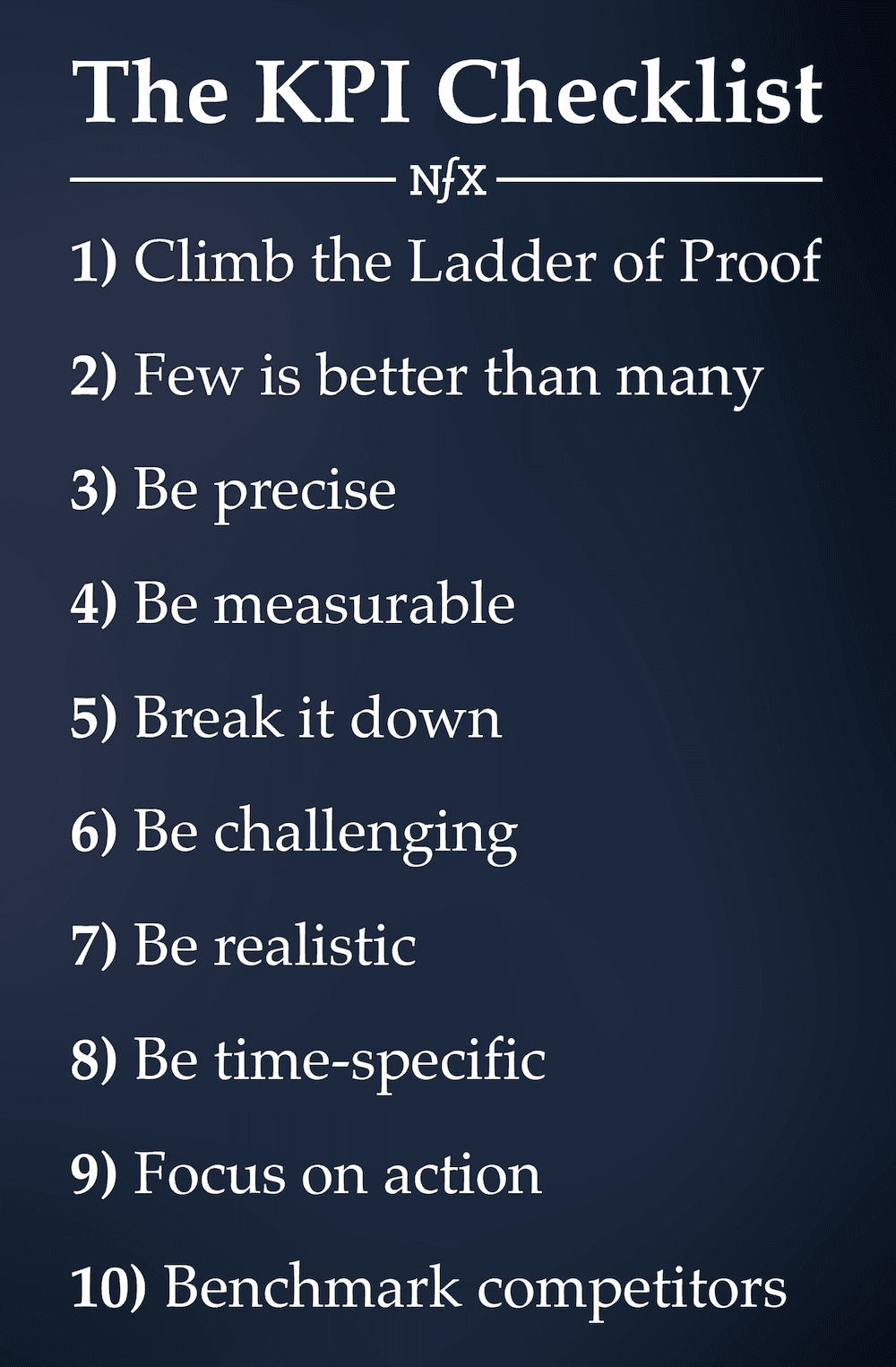Most Founders I meet with think they’re data-driven. In reality, few are. Everyone knows that KPIs are critical, but often Founders are not looking at KPIs from the right angle. As a four-time CEO, I had to learn early-on how to choose KPIs based on goals that actually build companies. Now as a VC, there are three questions I ask every Founder I meet. Their responses speak volumes about their odds of success:
- Do you diligently track KPIs?
- What KPIs have you chosen to track?
- Have you set appropriate goals based on your KPIs?
How I Can Tell If You’re Tracking KPIs
When I’m looking at a startup that has progressed beyond the seed stage, especially in the B2C space, I often ask the Founder to send me their daily report. If they don’t have a daily report or tell me it’s going to take a few days, the conversation is over. And if the Founder is only tracking one number, that’s a problem too (unless the analysis around the number is something truly brilliant). The daily report is a good filter for B2C startups, and also for most B2B companies.
What I See In Your KPIs and Goals
Real KPIs are specific, measurable, actionable metrics that are consistently tracked – preferably with a dashboard. I’m a big fan of making KPIs as visible as possible when the time is right, like having big monitors with your KPIs displayed all around the office so everyone can see them. As an investor and former Founder myself, this is what I’m always looking for.
Unfortunately, it’s all too easy to make mistakes in choosing KPIs, and I often see Founders making the same kinds of mistakes repeatedly, like tracking vanity metrics or no metrics at all. It’s equally tough to set the right goals based on those KPIs. And tracking towards the wrong goals can be even more counterproductive than failing to track anything at all.
The KPI Checklist
The thing about KPIs is that they’re harder than they first appear. Here are 10 guidelines I recommend to Founders when they’re developing their KPIs to ensure they are the right ones, the kind of KPIs that help startups breakthrough and win.


1) Target the next step in the “Ladder of Proof”
The KPIs you have should always aim to move you up the next rung in the Ladder of Proof, a framework for whether your startup is venture fundable that my Partner James Currier recently shared. The top priority of a startup changes at different points in its lifecycle, and so should its KPIs.
It doesn’t make sense to be tracking, for example, far-away proof points like indicators of revenues or gross margin when you’re still trying to figure out early retention. Focus on what’s in front of you and choose KPIs that serve your next step in the Ladder of Proof. Once you climb to the next step, you can always switch your focus to the next important KPI.
2) Few is better than many
Sometimes when I ask an early-stage startup for KPIs, they’ll have a long list of 20 metrics. This is way too many. When I get a list of 20 KPIs, I know that only a few can be really important, and it tells me that the company probably isn’t prioritizing the KPIs that matter most.
At any given point, everybody in the company needs to know which KPIs everyone else is focusing on. If you have too many, this simply won’t be possible.
3) Be precise
I remember talking to a marketplace company about their retention metric. The CEO had “7 day retention” as a KPI, but when I asked him exactly what that meant and where he had defined it, he said it didn’t need to be written down because everyone knew what it meant.
So I went and spoke to a mid-level manager and asked him whether he thought the KPI meant retention of the cohort on the week starting with day 7 or on the week ending with day 7. I got conflicting answers, and it turned out that different people at the company had different understandings of the metric. This was obviously a big problem.
And this is why it’s so important to define your KPIs with extreme specificity — so that everyone knows exactly what you’re talking about. Make sure that you use industry standards where they exist, too. If you use your ‘own’ version of a standard KPI you’ll lose a lot of points with investors when they find that out.
4) Be measurable
You’d be shocked how many companies I talk to tell me they are “aiming to improve” X, Y, or Z when I ask about KPIs.
Directional indicators are not KPIs. Non-measurable KPIs are worthless, especially for startups. There’s no room for fluff. Unless a KPI can be quantified, measured, and tracked, it’s too vague to be useful. “Improving retention” is not a KPI. “More website traffic” is not a KPI. Be measurable in setting your goals. In general KPIs, should be quantified and you should be able to present their progress on a graph.
5) Break it down
High-level, cross-company KPIs are hard for employees to translate into their day- to- day. Are your KPIs broken down into small enough pieces so that they can be acted upon? Break KPIs down into subsets that are relevant to each individual and/or team. That way, each employee knows exactly what their responsibility is, and how their work maps against the cross-company KPIs.
If you’re a head of customer success and the company KPIs are currently “get revenues to $10 million and increase profitability to 25%”, what does that mean for you? The KPI needs to be connected to your everyday job, otherwise the KPI is only useful for senior managers and not helpful to the organization as a whole.
6) Be challenging
Everyone agrees that easy goals are useless. But KPI goals that are too easy aren’t neutral: they’re actively harmful. I’ve watched countless companies set their bars too low and lose motivation. KPI goals are meant to motivate. When they’re too easy to accomplish they demotivate the team. Motivation does not survive complacency.
7) Be realistic
Although it’s important to be challenging, setting KPI goals that are too daunting or unrealistic can also demotivate. If the team doesn’t believe they have a realistic shot at accomplishing the goals you set, they’ll quickly become demoralized. So setting the right KPI goals is a balancing act between making difficult and yet realistic. On the one extreme you risk complacency, on the other extreme you risk demoralizing your team.
8) Be time-specific
Getting to $1 million ARR in 6 months is a very different thing than getting to $1 million ARR in 6-years. Think about it: almost every KPI becomes a completely different thing depending on its time scale. Be time-specific about your goals.
9) Focus on action
Do your KPI goals lead to action? If you state a KPI goal, are people going to understand what they need to do to get there? Unless goals lead to action, they’re just words. KPI goals should have a clear path to action.
10) Benchmark against competitors
Your competitors’ KPIs are a goldmine. You should be constantly searching for them.
While I was at Playtika, a company with a $4.4B exit, I remember being at the office of a big tech company and hearing that one of our competitors was seeing numbers on mobile that dwarfed our retention and monetization on desktop. We immediately switched our focus to mobile. Had we not heard about those KPIs we would’ve arrived to mobile a year too late, and the company probably wouldn’t have been as successful. Competitor KPIs can truly change your company – so keep looking for them everywhere.
As Founders ourselves, we respect your time. That’s why we built BriefLink, a new software tool that minimizes the upfront time of getting the VC meeting. Simply tell us about your company in 9 easy questions, and you’ll hear from us if it’s a fit.
Try ChatNFX

